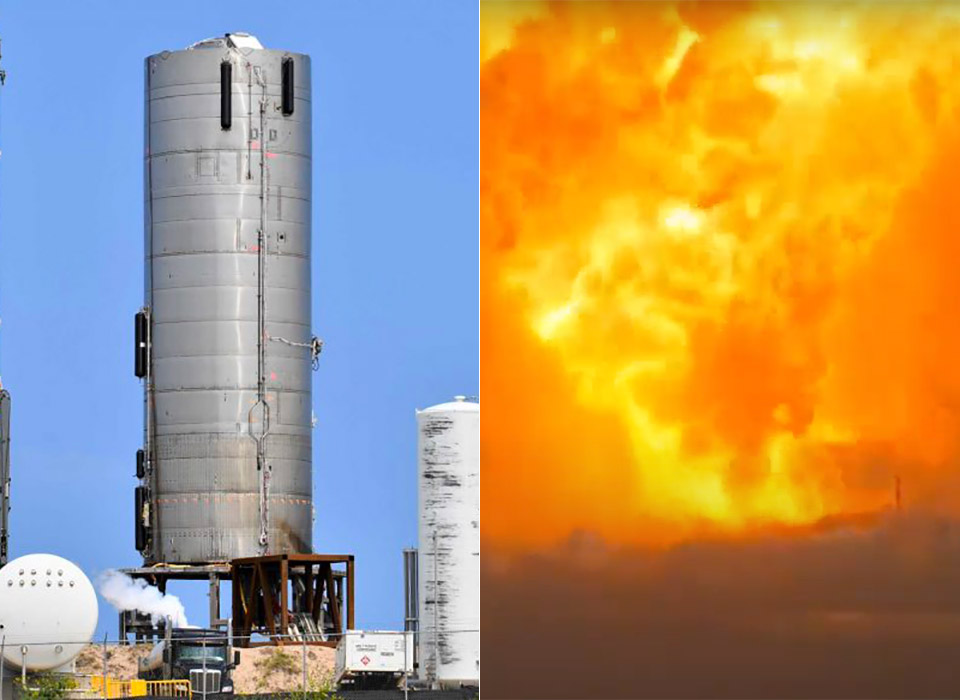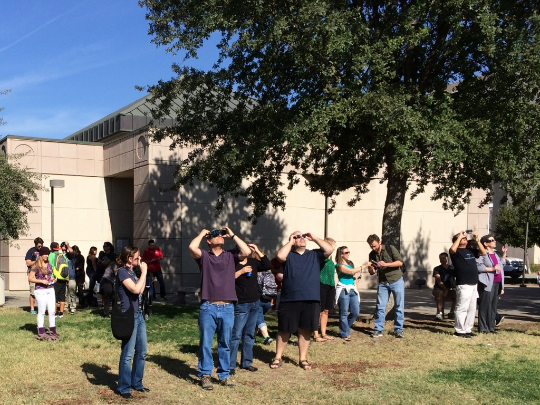Downing Planetarium
Latest News
The Downing Planetarium offers field trips for schools and public programs one weekend per month. On teh weekends, free parking is available in Lot P15, directly to the west of the planetarium. Reservations for our weekend shows are recommended. The latest news of the planetarium is featured below.
Solar Eclipse, Monday April 8th! Telescopes and Free Shows!
There will be a partial solar eclipse on Monday, April 8th, 2024. The eclipse will begin at 10:12 am and conclude at 12:20 pm. We will have telescope viewing in front of the planetarium. You can bring your own eclipse filter glass or purchase them from us for $5. We will have a planetarium program about eclipses in the planetarium theater at 11:30 am and 12:15 pm. The program is free and reservations are not required but seating is limited to 72 per show. If there is interest, we will also run the program at 1:00 pm. Please be sure to join us and see the Sun 51% blocked by the Moon or you can miss it and wait until January 14, 2029 for the next one!
New Planetarium Programs for 2021
We have been working on some great new shows for our re-opening.
Out of all the planets in the solar system, Mars is the planet most like Earth. In the future, Mars may become alike a second Earth but we need to get there to make it happen. NASA and others have their sights set on the Red Planet and are building the technology that would allow humans to reach Mars. See the new rockets under construction and fly through the International Space Station, where astronauts are already living and working in space. Mars is waiting, are you ready?
August 12, 2021
Perseid Meteor Shower Peaks Tonight!
The annual Perseid meteor shower will peak tonight in the early morning hours of August 12, 2021. The meteors are small particles of ice and dust that enter the Earth's atmosphere at high speed and create a glowing trail of plasma. The particles are the debris shed from the Swift-Tuttle comet. Fortunately, most of the recent smoke has cleared away from the Fresno area so it will not hide our view of the meteors. Also, the Moon will not interfere with the observations this year since it only a few days past New Moon and so the Moon will set early in the evening. For viewing the meteors, try to get to a dark location, away from city lights. Use a lawn chair, lay back, and try to observe as much of the sky as possible at once. Under good conditions, you might see as many as one meteor per minute! The greatest number of meteors are typically seen between the hours between midnight and dawn.
Venus and Mars are Alright Tonight!
Don’t miss a close appearance between Venus and Mars, low in the western sky, early this evening. Look for Venus first since it is the brighter of the pair. Next, check for Mars nearby in the 8 o’clock position. The separation between the two will only be about ½ of a degree. In addition, a thin waxing crescent moon will be slightly higher and to the left. If you watch each evening, the planets will appear to drift slowly apart.
May 26, 2021
Total Lunar Eclipse
There will be a total lunar eclipse visible from Fresno in the early morning hours of Wednesday, May 26th, 2021. Lunar eclipses occur when the Full Moon passes through the shadow of the Earth. During the eclipse, the Moon will appear to darken and turn red in color. No special equipment or eye protection is needed when viewing the lunar eclipse.
Eclipse Starts 1:47 am PST
Maximum Eclipse 4:18 am PST
Eclipse Ends 5:52 am PST
February 18, 2021
Perseverance to Land on Mars
December 9, 2020
Boomtime
On December 9, 2020 history was made when SpaceX launched the Starship prototype SN8 to an altitude of 12.5 km. The stainless steel rocket was powered by three advanced Raptor liquid fueled engines which burn a mixture of methane and oxygen to produce a clean blue flame. The shiny silver rocket rose gracefully into the beautiful Texas sky as people watched online in amazement from all over the world. As the Starship continued to climb, the engines were shut down, on purpose, one by one. The flight path was controlled by computers which point, or gimbal, the engine nozzles as needed to maintain stability. Once the desired maximum altitude was reached, jets of gas were fired from the nose of the rocket to change its orientation for the return to Earth in an untried new maneuver called the “belly flop”. The descent was automatically controlled by pairs of movable flaps in the nose and tail. This part of the flight provided convincing evidence that descent could be successfully controlled with flaps much smaller than the wings of the Space Shuttle. As the rocket approached the ground, two of the engines were re-lit with the nozzles at full tilt in order to provide the sideways thrust needed to right the rocket. Unfortunately, the pressure in the small methane header tank was not high enough to run the engines at full power for the landing burn. The flame turned green as the oxygen rich mixture consumed the copper in the rocket engine. The otherwise successful test flight ended in a spectacular explosion as SN8 slammed into its landing pad. Overall, the flight was an astounding success and provided valuable data to SpaceX engineers for future refinements to the design. If you missed the flight, don't worry, the next Starship, SN9, is expected to launch in January 2021. Stay tuned!
June 2020
Starship Experiments Continue
Right now, in Boca Chica, Texas, SpaceX is building a massive, reusable rocket ship that may someday make voyages to the Moon, Mars, and beyond reality. The rocket is called Starship and it will be launched atop a gigantic reusable booster called Super Heavy. Six prototypes have been built so far in only seventeen months. Unfortunately, all of the rockets have been accidentally destroyed in testing. However, every failure leads to new knowledge which is used to improve the next rocket. The rocket SN4 almost made it all the way to launch before it was destroyed in a massive explosion. Don't worry, Starship SN5 and SN6 are almost ready for their turn at the test stand.




